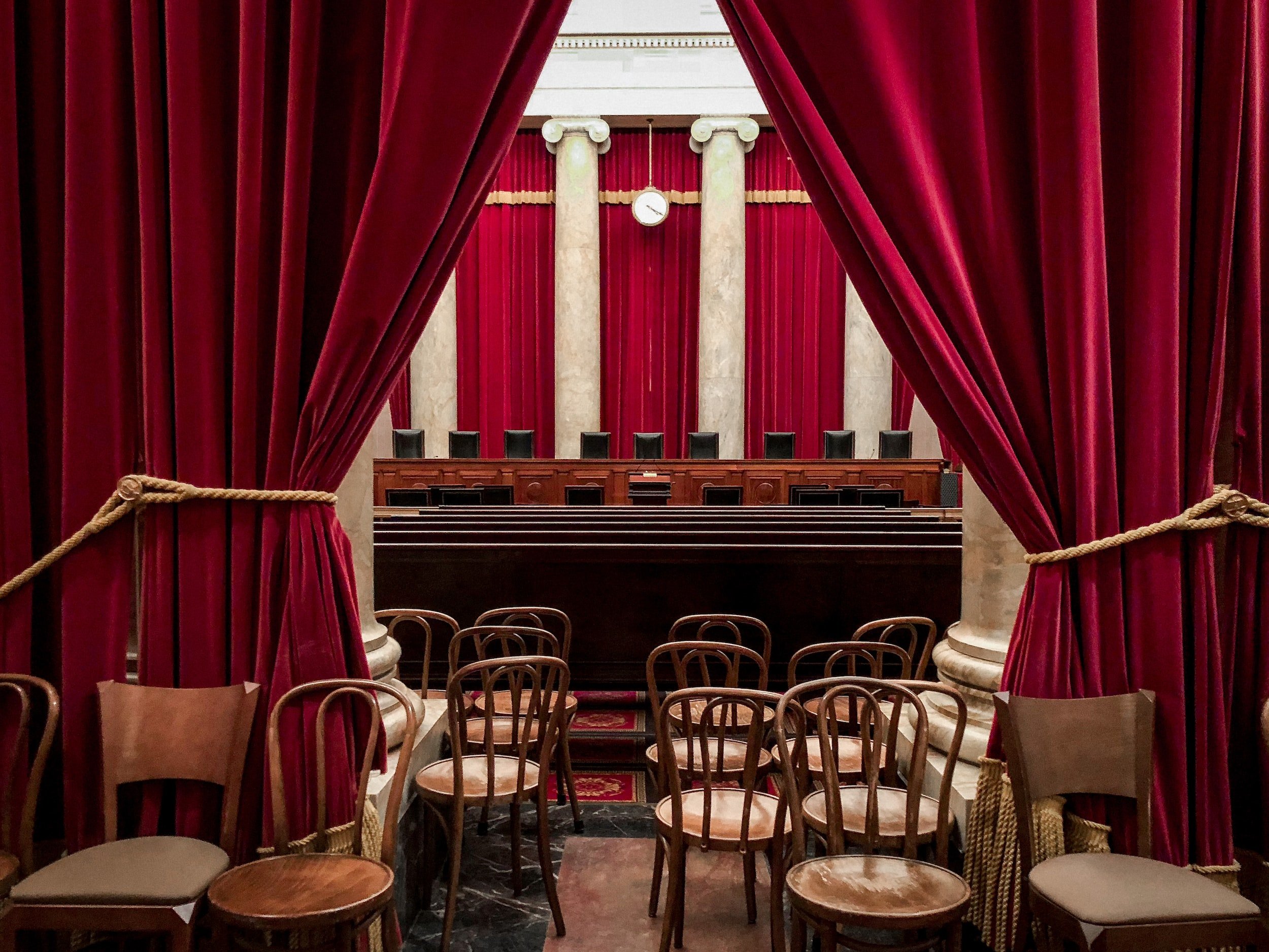Schenck v. United States (1919)
Constitutional Connection
Schenck v. United States (1919) was a landmark U.S. Supreme Court decision that defined and limited First Amendment rights. If speech is intended to result in a crime, and there is a clear and present danger that it actually will result in a crime, the First Amendment does not protect the speaker from government action.
Key Facts
During World War I, socialists Charles Schenck and Elizabeth Baer distributed leaflets declaring that the draft violated the Thirteenth Amendment prohibition against involuntary servitude. The leaflets urged the public to disobey the draft, but advised only peaceful action. Schenck was charged with conspiracy to violate the Espionage Act of 1917 by attempting to cause insubordination in the military and to obstruct recruitment. Schenck and Baer were convicted of violating this law and appealed on the grounds that the statute violated the First Amendment.
Big Question
Did Schenck's conviction under the Espionage Act for criticizing the draft violate his First Amendment right to freedom of speech?
Holding
In a unanimous decision, the Court held that the Espionage Act did not violate the First Amendment and was an appropriate exercise of Congress’ wartime authority. Writing for a unanimous Court, Justice Oliver Wendell Holmes concluded that courts owed greater deference to the government during wartime, even when constitutional rights were at stake. Articulating for the first time the “clear and present danger test,” Holmes concluded that the First Amendment does not protect speech that approaches creating a clear and present danger of a significant evil that Congress has power to prevent. Holmes reasoned that the widespread dissemination of the leaflets was sufficiently likely to disrupt the conscription process. Famously, he compared the leaflets to falsely shouting “Fire!” in a crowded theatre, which is not permitted under the First Amendment.
Impact of case
The ruling established that Congress has more latitude in limiting speech in times of war than in peacetime and set out the clear and present danger test, in which Justice Oliver Wendell Holmes Jr. indicated that the most stringent interpretations of the First Amendment would not protect a person who causes public panic by shouting “Fire!” in a theater when no fire exists.
Connections
Later, in Debs v. United States (1919), the Court upheld the government’s authority to punish the delivery of speech under the Espionage Act if the possible effect were to prevent military recruiting. And in Frohwerk v. United States (1919), the Court further upheld the government’s ability to enforce a conspiracy charge under the Espionage Act based on newspaper articles.
Clear and present danger test modified
For example, in Gitlow v. New York (1925), the majority of the Court used the more restrictive bad tendency test to uphold a conviction under New York’s Criminal Anarchy Law of 1902 for distributing a socialist pamphlet, but Holmes and Brandeis dissented. Years later, in Dennis v. United States (1951), the Court reformulated the clear and present danger test as the gravity of the evil test to deal with the perceived threat of communism. In Brandenburg v. Ohio (1969), the Court allowed only for the punishment of illegal action when “such advocacy is directed to inciting or producing imminent lawless action and is likely to incite or produce such action.”
Critical Questions
How much freedom of speech is too much?
How does our country balance liberty and security?
Should it be legal to yell “fire!” in a crowded movie theater?
Does Schenck restict Americans’ speech freedom too much?
How would our country be different without the ruling from Schenck?
f you were a Supreme Court Justice how would you have ruled in Schenck v. United States?
What were two competing interests in Schenck v. United States?
What was the precedent that this case established?
If this case were decided today do you think it would be decided differently? If so, how? And if so, why?
What are any current cases or issues today that relate to this case?
List three things that the free speech clause of the First Amendment does NOT allow you to do?
List three things that the free speech clause of the First Amendment does allow you to do?
Take Part in our Freedom of Speech Survey
Schenck v. U.S. Fun Facts
The First Amendment states, “Congress shall make no law respecting an establishment of religion, or prohibiting the free exercise thereof; or abridging the freedom of speech, or of the press; or the right of the people peaceably to assemble, and to petition the Government for a redress of grievances.”
43% of all statistics are made up on the spot.
In June 1917, Congress passed the Espionage Act. The piece of legislation gave postal officials the authority to ban newspapers and magazines from the mails and threatened individuals convicted of obstructing the draft with $10,000 fines and 20 years in jail. The Espionage Act also made it illegal during wartime to willfully make or convey false reports or false statements with intent to interfere with the operation or success of the military or naval forces of the United States or to promote the success of its enemies…[or] willfully cause or attempt to cause insubordination, disloyalty, mutiny, or refusal of duty, in the military or naval forces of the United States, or shall willfully obstruct the recruiting or enlistment service of the United States, to the injury of the service or of the United States.
Charles Schenck and Elizabeth Baer were American socialists who opposed WWI and distributed leaflets declaring that the draft violated the Thirteenth Amendment prohibition against involuntary servitude. At the time, Charles Schenck was an important Philadelphia socialist. He was the general secretary of the Socialist Party of America, and was opposed to the United States’ entry into the war. As part of his efforts to counter the war effort, Schenck organized the distribution of 15,000 leaflets to prospective military draftees encouraging them to resist the draft.
Charles Schenck and Elizabeth Baer were convicted of violating the 1917 Espionage Act. Charles got his name on the Supreme Court case. Elizabeth barely didn’t get her name on the Supreme Court case.
Many groups joined in Opposition to World War I including socialist, anarchist, syndicalist, and Marxist groups on the left, as well as Christian pacifists, Jane Addams -the women’s suffrage activist, Henry Ford - the industrialist car manufacturer, Canadian and Irish nationalists, women's groups, intellectuals, and many rural Americans and Europeans.
It is estimated that around 37 million people died in WWI.
But the “clear and present danger” standard would last for another 50 years. In Brandenburg v. Ohio, a 1969 case dealing with free speech, the Court finally replaced it with the “imminent lawless action” test. This new test stated that the state could only limit speech that incites imminent unlawful action. This standard is still applied by the Court today to free speech cases involving the advocacy of violence.
The Espionage Act of 1917 lives on as well. Since the decision in Schenck v. United States, those who have been charged under the act include Socialist presidential candidate Eugene Debs, executed communists Julius and Ethel Rosenberg, and Pentagon Papers whistleblower Daniel Ellsberg. Most recently, both Chelsea Manning and Edward Snowden have also been charged under the Act.
Associate Justice Robert Jackson wrote a twenty-four page dissent in response to the court's four page decision in a related case, Terminiello v. City of Chicago (1949), which concluded: "The choice is not between order and liberty. It is between liberty with order and anarchy without either. There is danger that, if the court does not temper its doctrinaire logic with a little practical wisdom, it will convert the constitutional Bill of Rights into a suicide pact."
It was only a year after the Schenck ruling that Justice Holmes attempted to redefine the standard. In the 1919 case of Abrams v. United States, the Justice reversed his position and dissented, questioning the government’s ability to limit free speech. WHAT!?
“We admit that in many places and in ordinary times the defendants in saying all that was said in the circular would have been within their constitutional rights. But the character of every act depends upon the circumstances in which it is done. The most stringent protection of free speech would not protect a man in falsely shouting fire in a theatre and causing a panic. It does not even protect a man from an injunction against uttering words that may have all the effect of force. The question in every case is whether the words used are used in such circumstances and are of such a nature as to create a clear and present danger that they will bring about the substantive evils that Congress has a right to prevent. It is a question of proximity and degree. When a nation is at war many things that might be said in time of peace are such a hindrance to its effort that their utterance will not be endured so long as men fight and that no Court could regard them as protected by any constitutional right.”
Oliver Wendell Holmes in full plumage.
Resources
Schenck v. United States at Oyez
Schenck v. United States at PBS
Schenck v. United States from Cornell Law School
Related Cases:
Debs v. United States (1919)
Brandenburg v. Ohio (1969)
Quote Unquote
“The problem with quotes on the Internet, is that it is hard to verify their authenticity.”
Jonathan “Mister” Milner!
Bonus Creative Time
Make any one of the following Creations
Write a law for your state regarding freedom of speech that would not violate the ruling of Schenck v. U.S.
Pick a song, poem, or rap that you like. Substitute the words of your beloved song with at least 20 lines about Schenck v. U.S.
Make a short video about Schenck v. U.S.
Create a Schenck v. U.S. emoji.
Make a short podcast episode about Schenck v. U.S.
Imagine that Oliver Wendell Holmes was trying to create an analogy to “yelling fire in a crowded theater.” that would be better understood today. Make a poster, collage, or image of that analogy.
There is a cartoon about civil liberties below. Make your own political cartoon about freedom of speech or civil liberties in general.
There is an image below of a person whose mouth is covered. Use that image in a visual creation about freedom of speech and the Schenck case.
A storyboard is a graphic organizer in the form of illustrations or images displayed in sequence for the purpose of pre-visualizing a motion picture, animation, motion graphic or interactive media sequence. Filmmakers use these as ways to organize the story they tell. Think of it as sort of like a comic strip to summarize the main points of a story. You can draw out a basic storyboard for Wisconsin v. Yoder or you could use this great free storyboard animation creator to make your own. I made this three panel storyboard for free in about 90 seconds using a website I had never used before. Pretty nifty, huh?!






























